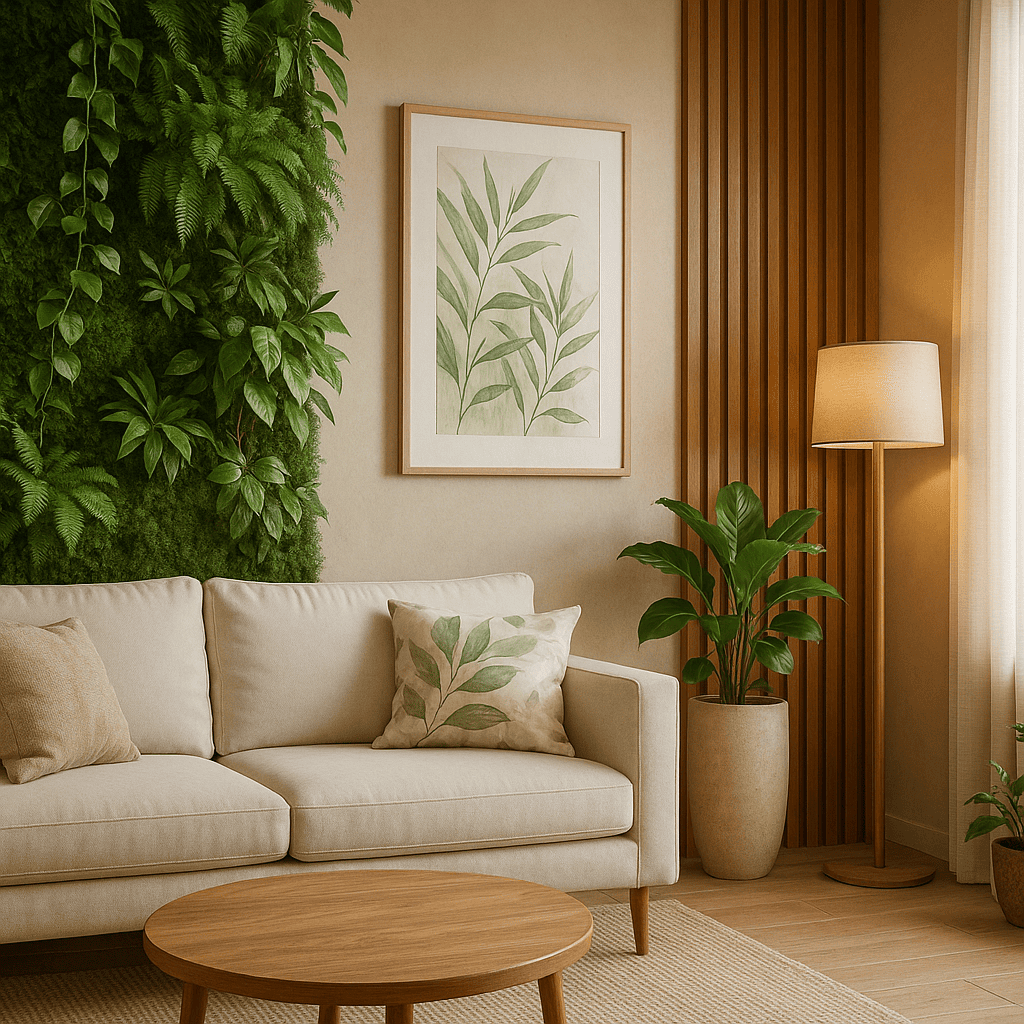
Biophilic Wall Decor Trends 2025 – Nature-Inspired Calm at Home
Biophilic Wall Decor Trends 2025 – Designing Spaces Where Nature Breathes
🧡 Walls are more than boundaries—they are canvases for connection. In 2025, the way we decorate our walls is shifting from mere aesthetics to emotional architecture. Biophilic wall decor brings the outside in, transforming static vertical surfaces into living, textured, and sensory experiences.
These aren’t just design choices—they are invitations. Invitations to pause, to breathe, and to live in sync with nature’s rhythms. Whether it’s a lush moss wall in your living room, bamboo slats in your reading nook, or a hand-painted forest mural in your hallway, biophilic design turns walls into sources of calm, focus, and life.
This movement is part of a larger wellness-driven interior trend in 2025, blending psychology, sustainability, and beauty into every design decision. In this guide, we’ll explore the science, trends, and practical ways to integrate biophilic wall decor into your home—no matter its size.
📚 The Science Behind Biophilic Design
Biophilia—our innate tendency to connect with nature—is not a passing trend; it’s hardwired into us. Studies in neuroarchitecture and environmental psychology show that exposure to natural elements indoors can reduce stress hormones like cortisol, improve focus and cognitive performance, and enhance mood and emotional resilience.
When applied to walls, biophilic design goes beyond hanging a botanical print. It’s about engaging multiple senses—textures you can touch, greenery you can smell, lighting that changes through the day, and patterns that mimic nature’s fractals.
Soft green tones, organic shapes, and diffused lighting have been shown to activate the parasympathetic nervous system, shifting the body into “rest and digest” mode. This creates a physiological sense of safety, calm, and belonging—crucial in our overstimulated digital age.
✨ Key Biophilic Wall Decor Trends for 2025
- Living Plant Walls – Vertical gardens using easy-care species like pothos, ferns, and moss create a constant, evolving connection to nature. Self-watering systems make them low-maintenance, and modular panels allow for flexible designs in any room size.
- Natural Material Panels – Wood slats, bamboo, cork, and rattan bring warmth, texture, and acoustic benefits. In 2025, these are being combined with LED backlighting for a dramatic yet soothing effect.
- Organic Murals – Hand-painted landscapes, watercolor botanicals, and abstract patterns inspired by leaves, waves, and rock formations turn walls into immersive art pieces. These murals often use eco-friendly, non-toxic paints to align with sustainability values.
- Textured Greenery Frames – Framed moss art or preserved plant installations give the lushness of greenery without ongoing upkeep. They’re ideal for small apartments or low-light areas.
- Light-Integrated Walls – LED panels that mimic natural sunrise and sunset cycles help regulate circadian rhythms. Combined with natural materials, they create walls that are both functional and atmospheric.
🌱 Bringing Nature Home: How to Apply These Trends
You don’t need to overhaul your entire home to embrace biophilic wall decor. Start small:
- Add a preserved moss frame to your entryway.
- Install bamboo paneling behind your bed for a tactile headboard wall.
- Place a vertical plant system in your home office for daily green exposure.
For a bolder statement:
- Cover a full wall with cork tiles for texture and warmth.
- Create a DIY living wall with modular planters and self-watering irrigation.
- Integrate water features—like a wall-mounted fountain—for both sound and movement.
Tip: Position biophilic walls in high-use areas—living rooms, offices, kitchens—so you reap the benefits throughout the day.
📌 The Emotional Impact of Biophilic Walls
Biophilic walls do more than look good—they make you feel good. Imagine working at your desk beside a lush vertical garden: subtle fragrance in the air, shifting light on leaves, and a reminder of the forest even if you live in the city.
In a world dominated by screens, these walls offer a visual and sensory break—a way to recalibrate your nervous system and anchor yourself in the present moment.
📊 2025 Trends Driving Biophilic Interiors
- Hybrid Homes – Spaces now serve work, rest, and social functions, making restorative design a must.
- Sustainable Luxury – Eco-friendly materials are replacing synthetic finishes in high-end decor.
- Dopamine Design – Mood-boosting colors and tactile finishes layered into natural palettes.
- Tech-Nature Fusion – Smart irrigation, light systems, and air-purifying wall installations.
🧠 Scientific Support – Why This Works
A 2023 Harvard T.H. Chan School of Public Health study found that indoor greenery improved focus by 15% and reduced stress by 25%.
Fractal pattern exposure—common in nature—increases alpha brainwaves, linked to creativity and calm.
Natural light synchronization improves sleep quality and mood regulation.
💬 FAQ
Q1: Are living walls hard to maintain?
Not with modern technology. Many systems are self-watering and use low-maintenance plants.
Q2: Can I get the benefits without live plants?
Yes—natural materials, textures, and nature-inspired art also trigger biophilic responses.
Q3: Is this suitable for small apartments?
Absolutely—framed moss art, preserved plant panels, and vertical gardens maximize small spaces.
🎯 The biophilic wall decor trends of 2025 are more than a design choice—they’re a statement of values. They say: I choose spaces that heal, not just impress. I choose to live in connection, not isolation.
By letting nature breathe through your walls, you’re not just decorating—you’re transforming your home into a living ecosystem that supports your mind, body, and spirit.
✨ So, which corner of your home will you let nature reclaim this year?

